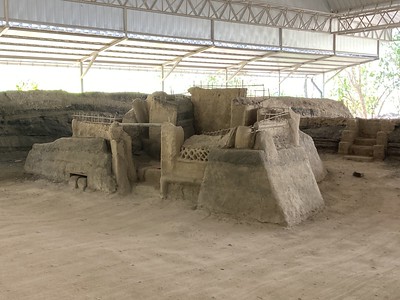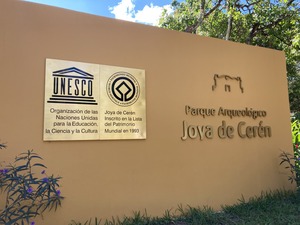Joya de Ceren

The Joya de Cerén Archaeological Site is a pre-Columbian Maya farming village that has been preserved after it was destroyed by volcanic ash around 600 CE.
It provides an excellent testimony of the daily lives of ordinary people, as they left behind utensils, ceramics, furniture, and even half-eaten food in their haste to escape the eruption of the Loma Caldera volcano. The remains of the earthen architecture have also been preserved.
Community Perspective: the site is easily reached by public bus, either from Santa Ana or San Salvador. Visiting the on-site museum with original excavated items is recommended to do first. The earthen buildings are very much intact, but do not expect grand stone buildings like in other Maya sites.
Map of Joya de Ceren
Community Reviews
Els Slots

I visited the lovely site of Joya de Ceren in February 2022, not long after its full reopening. El Salvador's one and only WHS had been closed for a full makeover and subsequent Covid measures for most of the time since late 2019. The site from a visitor’s perspective is now in a very good state. Striking is the French support that has gone into the restoration (they apparently paid 70% of the bill of 1.3 million US dollars). The museum has been modernized, good information panels have been placed (in Spanish, English, and of course in French), the site has been made accessible for the blind and the protective shelters have been made higher/larger so that you have a better view of the ruins.
I covered the 40 kilometers between San Salvador and Joya de Ceren in a genuine chicken bus: bus 108 that leaves from Terminal de Occidente. The ride cost only 0.50 US dollars and took 1.5 hours. The bus stops in front of the entrance of the archaeological site, just after crossing a large orange bridge. On the way back I had a “better” bus, with actual seats instead of benches – for an additional 0.25 US dollar I was back in the capital within the hour.
Probably as the result of the refurbishments, the entrance fee for foreigners has risen from 3 to 10 US dollars! They do practice foreigner pricing here and the locals still pay the previous 1 US dollar (notwithstanding that they can afford a 10+ dollar meal in a PizzaHut or Denny’s). I arrived at the same time as a van with American tourists. I avoided them immediately by entering the museum first. The day before I already went to the (National) Anthropological Museum of El Salvador, where you can see similar things. The finds mainly consist of ceramics and food remains. The archaeologists preserved the latter by means of plaster casts, just like in Pompeii.
The excavation site is protected by two large coverings. The buildings of this Mayan village were made of adobe with thatched roofs. I had prepared myself for a setting like a tell (a pile of rubble), but the actual buildings are very much intact. The archaeologists here leave a large part of the ash layers (up to 10m high!) intact, they still offer some stability to the vulnerable adobe remains. Excavations are still underway and some parts of the site are covered up.
You walk around the site via a designated route, from where you view the excavations from above. I actually walked this route twice, as the American guide was a bit too loud and I skipped parts on the first round. The route passes 10 named excavated objects. A typical building is perhaps the biggest eye-catcher of the entire complex: a temazcal, a sweat lodge that was used for purification. It has a domed roof that was slightly damaged by the volcanic eruption or the preceding earthquake. At the end of the route lies a replica of this temazcal, where you can also view this structure from the inside (on your knees).
Under the second covering, the remains of a kitchen, storage rooms, and agricultural gardens can be seen. Joya de Ceren for example has the first identified instance of manioc cultivation in the Americas. The House of the Shaman is also located there. The shaman was a woman— she led the maize harvest rituals. A ritual mask has been found.
This site of course does not have grand stone monuments like the big Mayan cities. But a village like this (it probably had 200 inhabitants) also entailed more than a few huts and sheds. Combined with the onsite museum, it gives you a good idea of daily life in Mayan society at the fringes of Mesoamerica.
Read more from Els Slots here.
Ammon Watkins

After some problems and delays in Nicaragua we found ourselves having to scale back our plans through El Salvador. Fortunately there is only one WHS to visit and it remained our priority. The worst thing you could do when visiting this site is expect it to be anything like any of the well known Mayan ruins in the region. This one is small scale and has obvious OUV that is more archaeologically technical than of broad appeal to the casual tourist. There are no major structures here and the village is believed to have only existed for 30 years or so before it was abandoned and buried by ash. Having said that we enjoyed our visit and found it to be a nice compliment to our overall understanding and appreciation for all things Mayan. The small museum on site is informative and a visit there first is necessary preparation for understanding the rest.
Although more have been found there are about a dozen structures, divided into 3 separate covered areas visible from above. Unlike many other Mayan ruins there is no climbing on and touching these ones. The path is above and you look down through the 14 layers of ash at what has been uncovered. The details are hard to pick out but you can get some sense of the size of the homes and their relation to one another in the village that once was. We were through it all in about an hour and entry was only $3 which was refreshingly affordable.
The site is easily reached by public bus. We visited as a day trip from Santa Ana and even with a required change of buses still made it there in under an hour. For those wanting more there are many other small archaeological sites in the area including the larger Mayan city of San Andres which was the administrative center for the region that included Joya de Ceren.
Michael anak Kenyalang

I visited this WHS in September 2016 during my Latin Grand Tour which last for 7 months. This is a very interesting WHS as most of the WHS in Latin America are related to Aztec, Mayan, Inca or Spaniards glory history, and Joya de Ceren is more to the daily life of the Pre-Columbian Mayan 1400 years ago. The ashes from the nearby Loma Caldera volcano eruption covered and preserved the site in time capsule, just like Leon Viejo and Pompeii.
I recommend to visit the museum first before entering the archaeological site so that one will have a better understanding of what's in the archaeological zone. Most of the excavated items are here, for example you can see many ceramics with drawing of animal found in jungle like monkeys and birds. The most interesting item I found in the museum is the carbonized corn. This is the evidence of Mayan domestication of plants and up till today the Latinos are still eating corn as their main food.
Joya de Ceren was a small Mayan village with 10 structures including some houses and storehouses. There is also a temazcal where the Mayan used as a sweat lodge to heal sickness. The site is not big and it will only take you around half an hour but interesting enough to be the only WHS in El Salvador.
Lars Svendsen
In 1990 I was on the Joya de Ceren archaeological team of Andrea Gerstle. There were six of us and many wonderful locals who housed us and fed us and worked with us at the site. We found the third house, in fact Jose and I found it, 15 feet down when we scooped up a fragment of what turned out to be the wall of a rammed earth house.
Magnificent site. As noted it tells a tale of life among the 'common' people.
"Certainly the American continent was far better off before the journeys of Columbus and the European takeover." Andy, How do you know this? There is nothing in the record to suggest that pre-columbian America, anywhere, was paradise. Especially in this neck of the woods.
The Maya rulers where Kings and Gods at the same time. The Spanish Kings were no longer 'Gods' but might as well have been.
When you get into the mix of it all most of the world has evolved about the same way. Because Andy, 'WE ARE ALL HUMAN AND HUMAN NATURE DOES NOT CHANGE VERY MUCH IN THE SCHEME'.
Tammy Glaser
We absolutely marveled at Joya de Ceren! It truly is a jewel and must not be missed when traveling in El Salvador. My husband is Salvadoran and American and he was so proud of his country and what they have uncovered. The museum was fantastic, the tour informative, and the landscaping meticulous.
I blogged our visit plus a bunch of pictures, which do not do justice what you see in real life. aut2bhomeincarolina.blogspot.com/2010/10/joya-de-ceren-archaeological-site.html
Andy
I had a wonderful time at the site about ten years ago and greatly enjoyed all that there was to learn and particularly the contrast with the Mayan ceremonial cities. However, I have to disagree with Ivette, though. We have not advanced at all. On the contrary, life remains very harsh for the poor majority. The environmental and social degradation a bus ride away in San Salvador with many people living in absolute misery is a vivid reminder of this. Certainly the American continent was far better off before the journeys of Columbus and the European takeover.
Community Rating
- : Michael anak Kenyalang Sabrina Liebehentschel
- : Miguel Marquez Digits
- : Larry F Christoph Dennis Nicklaus
- : Ammon Watkins Sutul Carlo Medina Ctravel
- : John Smaranda Els Slots Hanming Mikko George Gdanski Carlos Sotelo Frederik Dawson Alejandro Lau Eva Kisgyorgy
- : GeorgeIng61 Everett João Aender
- : Alberto Rodriguez Gutierrez Thomas van der Walt Paw90 Gary Arndt Zoë Sheng Jon Opol Philipp Leu Dorejd
Site Info
- Full Name
- Joya de Ceren Archaeological Site
- Unesco ID
- 675
- Country
- El Salvador
- Inscribed
- 1993
- Type
- Cultural
- Criteria
-
3 4
- Categories
- Archaeological site - Pre-Columbian
- Link
- By ID
Site History
1993 Inscribed
Site Links
Unesco Website
Official Website
In the News
Connections
The site has 16 connections
Constructions
Damaged
History
Science and Technology
Timeline
Trivia
Visiting conditions
WHS Names
World Heritage Process
Visitors
79 Community Members have visited.
The Plaque
 (photo by Els)
(photo by Els)